Table of Contents
Does it ever strike you as odd to buy single-use plastic trash bags that we fill with other trash and then… throw it all in the trash? There has to be a better way! And the reality is that prior to the 1950s or so, nobody had plastic trash bags but folks still managed to dispose of household garbage just fine. Happily, you have options a-plenty these days. Here are some ideas to avoid the need for single-use plastic trash bags, followed by recommendations for some of the best alternatives to plastic trash bags.
Before we get started though, a note on biodegradable trash bags
At first glance, it might seem that biodegradable trash bags are a great choice for the environment. The reality though is that this is tantamount to greenwashing. After all, the trash in the bag won’t biodegrade and the bag itself is unlikely to biodegrade in normal landfill conditions. Those biodegradable bags are also almost always made with synthetic polymers that are petroleum-based, meaning more microplastics in the environment.
All this means is you’re paying more for a product that required more energy and resources to produce than most plastic trash bags.
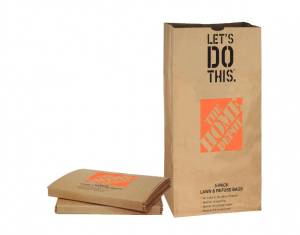
Our top pick for plastic trash bag alternatives
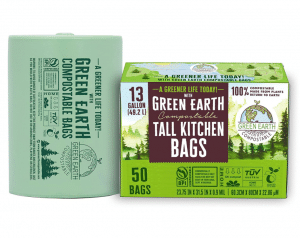
Great biodegradable trash bag option
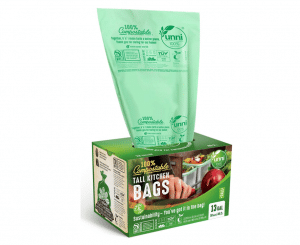
100% compostable trash bag that is earth friendly
Plant-based trash bags and compostable trash bags
Things get a bit confusing when talking about biodegradable, plant-based, and compostable trash bags. Companies tend to use these terms willy nilly, meaning we really have to be on our toes as consumers to avoid greenwashing (misleading marketing claims).
Plant-based can mean that some of the materials used to make the bags are sourced from sugar cane, corn starch, and other plant-derived materials. This sounds good, but it’s often the case that these bags are also made with virgin plastic. The result may be a bag that sounds more eco-friendly but actually performs worse than a bag made with a mix of recycled plastic and virgin plastic. And if you have to use two bags or more to handle your trash, the eco-friendliness really starts to fade rather fast.
In contrast, compostable trash bags are a great option as an alternative to single-use plastic trash bags. These bags are 100% plant-based and are designed to break down very quickly under certain conditions (typically high heat and moisture). This might meant they take longer to break down in landfill conditions compared to home composting, but when they do, they will not result in microplastics entering the environment.
Compostable trash bags are a good option for hauling green waste to a composting facility or for hauling or storing (temporarily) other dry items such as newspaper, straw, clothing, and so forth. Just be careful not to get these bags wet or to expose them to humid or hot conditions as they’ll start to break down regardless of what’s in them. And check for certifications when buying compostable bags. These include BPI ASTM D6400 in the US and Europe OK Compost Home in Europe.
What’s wrong with conventional plastic trash bags?
The impact of plastic trash bags is often overlooked but it really shouldn’t be discounted, especially as it adds up over the course of a lifetime. Most trash bags are made from virgin plastic and are single-use items, with a staggering number (likely in the billions) used each year in the US alone. Because these are mostly used to contain garbage that is destined for landfills, this plastic is highly unlikely to be recycled. And even if it was, the quality of the plastic is so poor that it’s very hard to use for anything else.
Once the bags arrive at the dump, the plastic can take more than 500 years to break down. And once it does, it turns into microplastics that can end up in waterways and soils, with negative effects on wildlife and water quality.
Before the plastic even gets to landfill though, it has already had a significant environmental impact. That’s because producing these bags requires oil extraction, transportation, and processing, all of which are energy-intensive, contribute to greenhouse gas emissions, and require the use of carcinogenic chemicals such as benzene and vinyl hydrochloride.
Plastic trash bags and your carbon footprint
What does all this mean for your carbon footprint? Well, let’s do some quick math. Polyethylene is the most commonly used plastic for trash bags and is responsible for about 6 kg of carbon dioxide (CO2) per kg of plastic. An average 49-liter plastic Glad kitchen trash bag weighs about 21.1 grams and a heavy-duty black trash bag weighs about 120 g. So, let’s assume a household uses one of each of these bags every week, amounting to around 140 g of polyethylene. Multiply by 52 weeks in a year and we have 7.28 kg of plastic.
By my calculations that amounts to almost 44 kg of CO2 annually, just for single-use trash bags. This is the equivalent of around 111 miles driven by an average passenger vehicle or the emissions related to charging your smartphone 5,352 times!
All said, the impact of these single-use plastic trash bags really starts to stack up over the months, years, and over the course of a lifetime. And with plenty of great alternatives to plastic trash bags available, now is a great time to try something new.
Eco-friendly trash bags: our top picks
Consider using one of the options further below, as these can help reduce resource use and/or give existing plastic a second go-around on its way to landfills.

Home Depot Paper Lawn Bags
Highlights: Classic heavy-duty paper bag for yard waste and more!
Home Depot offers some pretty robust Lawn and Leaf bags made from thick 2-ply paper. These are great for yard waste and can be a handy, eco-friendly alternative for household trash that is dry. You can also use these to store items you’d otherwise perhaps store in a plastic trash bag. And they hold up pretty well in the rain, for a short while at least.
The larger outdoor leaf bags hold 30 gallons and are fully biodegradable and compostable as they’re simply made with paper. And thanks to the hefty construction, these bags hold up pretty well to sticks and twigs, though aren’t entirely tear-resistant as they are after all made of paper. These bags are also handy in that they stand by themselves, making for easy filling, and they’re compact too, taking up little space when stored folded.

Green Earth Compostable Bags
Highlights: Certified for home composting in the US. Thicker than many compostable bags, with good strength.
Green Earth Compostable Biodegradable Tall Kitchen Trash Bags are certified for home composting in Europe (OK Compost Home) and under the BPI’s strict ASTM D6400 specification in the USA. The bags are made with non-GMO crops and offer a 49.2-liter capacity and good strength.
A great choice for bags that actually decompose and don’t just ‘biodegrade’, these bags are one millimeter thick, which is quite a bit more robust than most other compostable bags. And because they’re actually compostable, they need to be stored in a cool, dry place and used within one year.

UNNI 100% Compostable Trash Bags
Highlights: Certified in Europe and the US for home composting.
UNNI 100% Compostable Trash Bags are also ASTM D6400 certified and Europe OK Compost Home Certified. Measuring 0.71 mm thick and a little smaller than standard 13-gallon bags, these also lack a drawstring top and may be a bit tricky to use in larger garbage pails. Still, the bags are versatile and fairly robust, with a good reputation for resisting leaks and tears (though no compostable trash bag is as durable as a plastic trash bag, so treat with care!).
The bags will break down completely within 180 days as they are made entirely with plant cellulose.
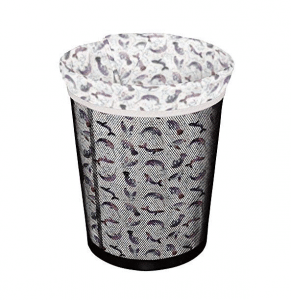
Planet Wise Small Diaper Pail Liner
Highlights: Fantastic reusable diaper pail bag that also works for bathroom, office, bedroom, and other household trash. Washable and waterproof, made without PVC, BPA, or lead.
If you’re looking for a reusable trash bag, Planet Wise is a great option. These 5-gallon bags work best for a 20-quart pail and are available in various colors and prints to coordinate with your nursery décor. Skip the single-use plastic diaper pail liner and use these washable, waterproof, and reusable bags instead. Super easy to use, these bags have an elasticated top and will fit most bins with a 34-56 inch circumference.
Unlike quite a few reusable bags, these are fully machine washable and can be dried on low or air-dried. The bags are made without PVC, BPA, or lead and have hidden seams and a waterproof inner liner made with PUL (polyurethane laminate) sealed for no wicking or leaking. It would be great if the PUL was made with recycled materials, but these bags are still a good step in the right direction.
A great choice for diaper pails, office trash, bathroom waste bins, and more, these bags can be easily decanted into a larger trash can or throw-away trash bag as needed.
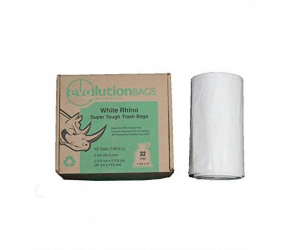
Evolution Trash Bags
Highlights: Recycled plastic trash bag made with 94% certified post-consumer LLDPE. Heavy duty and LEED compliant, and made by a 1% for the Planet member.
One of the best recycled material trash bags around, Evolution Trash Bags are super tough and made with 94% certified post-consumer recycled material (linear low-density polyethylene, LLDPE). These heavy-duty trash bags can hold 42 gallons and are 2 mm thick. They are EPA Compliant, ECOLOGO Certified, and qualify for the US Green Building Code LEED Program.
Evolution is also a member of 1% for the Planet and the company uses 100% recyclable packaging.
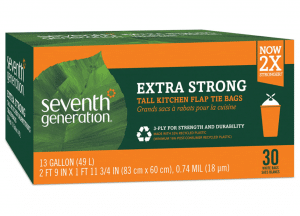
Seventh Generation Trash Bags
Highlights: Standard tall kitchen trash bag made with 55% recycled plastic (and 45% virgin plastic).
Seventh Generation Trash Bags are made with 55% recycled plastic (including 16% post-consumer recycled plastic). This is one of the highest percentages of recycled plastic material available for plastic trash bags and helps to reduce (but not eliminate) the use of virgin plastic for single use.
These tall kitchen bags can hold 13 gallons or 49.2 liters and are robust with a 3-ply construction and flap tie closure. Seventh Generation uses 70% post-consumer recycled plastic in packaging and all packaging can itself be recycled.
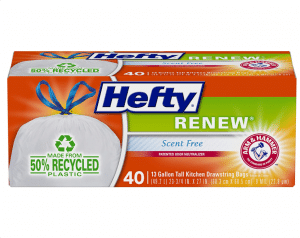
Hefty Renew Tall Kitchen Trash Bags
Highlights: Big name brand doing a bit better by the environment with this 50% recycled plastic trash bag. Beware, though, that these are ‘unscented’ but still seem to be very scent-heavy.
Hefty may be a big brand name but the company actually offers a plastic trash bag with one of the highest percentages of recycled material. The Renew line uses 50% recycled plastic and these tall kitchen bags can accommodate 13 gallons of trash with a drawstring closure for convenience. The bags are robust at 0.9 mm thick and are unscented but have a reputation for actually smelling very strongly. I’d suggest avoiding it if you have scent sensitivities.
Strategies to avoid single use plastic trash bags
Do without
That’s right, the simplest and most wallet-friendly alternative to plastic trash bags is… no bags. Depending on where you live and the kind of trash you’re throwing out, you may be able to have a reusable trash can that waste disposal folks can upend directly into the garbage truck or that you can take to the landfill and empty yourself.
Bear in mind that many municipalities actually mandate the use of garbage bags for the health and safety of workers and the environment (ironically). And if you live in an apartment building, using trash bags to send garbage down the chute may be mandatory. Otherwise, loose trash can go rogue instead of ending up safely in the garbage truck. Still, if you don’t have much trash to throw out and you make sure to separate recyclables, compostables, and genuine trash, this might be a good option once you’ve checked with your local government.
Use pet food bags
Most dry pet food comes in bags that are difficult for local recycling facilities to handle. You can save these up and send the bags to TerraCycle but another good option is to reuse them as trash can liners. If they’ll end up in the garbage anyway, and reusing these bags means you don’t need to buy a plastic bag specifically for trash, that’s a win-win!
Also, this strategy can encourage you to buy the biggest bag of pet food available, which is marginally more environmentally friendly than buying many smaller bags.
Reuse other single use plastic bags and packaging as trash bags
A lot of processed foods, clothing, technology, and other products come packaged with plastic bags. These single-use items aren’t always able to be recycled through curbside pick-up, depending on where you live, meaning they end up in the trash. Give them a new lease of life on the way to landfills by using them to contain other non-recyclable garbage. Sure, you may end up with a bin full of smaller plastic bags, but that’s okay, the trash is still contained.
Use a reusable trash bag
If you have multiple trash cans around the house, consider using reusable trash bags. Come garbage day, these can all be emptied into your main garbage bag or can for disposal and you can keep reusing the same bag over and over.
Reusable trash bags are often made with a small amount of recycled plastic material as a liner. This can help prevent spills from moist garbage, such as in bathrooms and so forth. Be sure to check the care guidance with any reusable trash bag as some can withstand hot water washing while others need to just be rinsed with cold water and wiped to avoid the liner breaking down prematurely.
Their blue recycling bag is made of RPET mesh to allow recycling to air dry and has a reinforced base so it doesn’t leak. Their green bag is a nonwoven poly/cloth blend and is intended for hauling yard waste to the compost collection site. They also offer a black bag intended to hold sports equipment. These reusable bags can be sprayed with a hose to clean and reused dozens of times. Reuse is always better than single-use products and eliminating plastic waste destined to be trash is a big win!
Make trash can liners from newspaper
If you’re up for a craft project, consider using old newspapers to make trash can liners. Similar to making seedling pots, just on a larger scale, this is a great way to skip the single-use plastic bags. There are plenty of online tutorials on how to do this, and it’s surprisingly simple and efficient, meaning you can create a stack of liners to see you through the year.
One top tip is to make the newspaper liner and then fold down the top, so when garbage day comes you still have a bit of room to fold the top of the liner over and keep things tidy.
This is a great option for households that compost and tend to only have a small amount of mostly dry waste. That said, if you can’t compost meat scraps and want to put these in the garbage, consider wrapping these in newspaper or flyers before putting them in your garbage can. This helps to keep the rest of the garbage from getting soiled. Or, to keep bacteria and odors at bay, freeze perishables that can’t be composted and then add these to the garbage on collection day.
Paper trash bags
Ideally, these bags are made with recycled paper and can withstand a little bit of moisture and rough handling. Look for two-ply versions or heavy-duty paper bags such as those sold at hardware stores for leaf litter and other yard waste. And if you do use these for small amounts of moist waste, consider wrapping the waste in paper prior to adding it to the can, as mentioned above. Check out the Home Depot lawn and leaf bags detailed above.
Recycled plastic trash bags
Far better than using virgin petroleum to make single-use plastic trash bags, garbage bags made from recycled plastic help to reduce resource use and temporarily keep plastics out of the waste stream. Sure, they’ll still (eventually) break down in landfills and create microplastics, but the kind of plastic used to make recycled trash bags is low quality anyway and would otherwise be difficult to recycle into anything else useful.
When considering these kinds of recycled plastic trash bags be sure to check for certifications. This offers some assurance that the bags actually contain a significant amount of recycled material and aren’t just packaged in a green box with a nice little leaf for show. I offer a few options for these below, with Evolution the best of the bunch.
What did we use before single use plastic trash bags?
It might seem unfathomable to us now but before the 1950s there were no plastic trash bags. In fact, growing up in England, my family had a stainless steel garbage can with a rubber lid and we didn’t have to use bin bags at all. These metal cans were a hassle to move around, but they sure were robust and sustainable! Prior to the advent of plastic trash bags, it was also common practice to reuse paper grocery bags to hold trash. When full or if particularly stinky, these went into the big metal household bin for weekly collection.
It should also be noted that folks likely generated a lot less trash some 60 years ago, given household consumption patterns and the relative reusability and durability of goods. So, naturally, one of the best ways to minimize the impact of your plastic trash bag use is to simply consume less by purchasing better quality products that last longer and can be repaired, upcycled, or recycled.
Home composting or using municipal composting facilities also helps keep your garbage can empty and odor-free. And, of course, properly rinsing and sorting your recycling and making use of any takeback programs, curbside pick-up or other options like TerraCycle boxes helps to minimize your need for trash bags and takes you a step closer to being a zero-waste household.
This was really helpful. I appreciated your bit at the end about “what did we do before trash bags??” That’s the question I like to ask too when it comes to becoming more sustainable.
Thanks!
Informative article. Thanks. Mainly addresses how to not use plastics–more than addresses the ecological impact of the product. The advice to use large paper leaf trash bags as an alternative ignores the vast damage that tree cutting has done.
I read “Finding the Mother Tree” by Suzanne Simard and am sick over the ecological damage that is done by clear cutting and so-called “reforestation” programs, by insensitive and ignorant paper companies. We need stop using plastic AND paper.
“What percentage of deforestation is caused by paper production?
The truth is, about 14% of deforestation is done to satisfy our huge appetite for paper goods [1]. This amounts to the destruction of around 4.1 million hectares of forest each year in the name of our paper obsession – an area the size of the Netherlands every 365 days.”
Hi Brenda,
Thanks for the comment. I also read (and loved!) Finding the Mother Tree.
You’re absolutely right that our best approach would be to reduce consumption as a whole, including plastic and paper. Ideally, we’d also increase the use of recycled paper goods and generally shift to a circular materials economy. In the meantime, the switch from plastic to paper is at least going to help a little and is something many people find easy enough to do.
Leigh